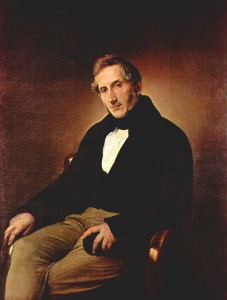
Alessandro Manzoni, an Italian poet and novelist, is best known for his book The Betrothed. Rev. Robert Sirico, president and co-founder of the Acton Institute, recently wrote an article for Crisis Magazine praising Manzoni and discussing some of the economic themes found in The Betrothed. Pope Francis is also a fan of the Italian writer. In his article, Rev. Sirico draws a connection between a sensible tradition of Catholic thought on economics and a work of literature that Pope Francis deems credible.
Sirico starts out by offering an introduction to The Betrothed:
The Betrothed is, as its title implies, an epic love story that traces the circumlocutions of the engagement of Lorenzo Tramaglino to Lucia Mondella across the magnificently described countryside of Italian Lake District and Milan. Though written in the early nineteenth century, the action of the novel takes place in the midst of the seventeenth century and depicts historical events and personages. It is no spoiler to say, and you will be relieved to know, that the boy gets the girl in the end and eventually marry. But it is what happens along that way that makes The Betrothed so engaging and instructive.
The novel’s antagonist, Don Rodrigo, is a Spanish foreigner exercising control in Italy’s northern region of Lombardy, which was the case in the seventeenth century. By the time Manzoni published the novel in 1827, Lombardy was controlled by the Austrian Empire and some speculate that Manzoni was drawing a comparison to the Austrian occupation in his novel.
The Betrothed fictionalizes in great detail the historical realities of the Thirty Years War and the Great Plague. Manzoni details the negative impact of price controls throughout Lombardia specifically and across Italy more generally with an amazing grasp of economics.
Manzoni implicitly lays out economic concepts in his writing:
Manzoni hits the economic nail right on the head by recounting the government’s attempts to mitigate the shortages its policies helped to create. Among the government “solutions” recounted by Manzoni are price-fixing, penalties applied to merchants who fail to adhere to government-set prices and other regulations. Such is the government’s shortsightedness, writes Manzoni, it is oblivious to the most obvious solution—attracting imports from areas recognizing crop surpluses. The worsening of the situation, in turn, exacerbates pleas from the populace for the government to intervene even more.
Manzoni draws a vivid analogy of the politicians to “behaving like a lady of a certain age, who thinks she can regain her youth by altering the date on her birth certificate.” I am reminded of Milton Friedman’s dictum: “There is a sure-fire way to predict the consequences of a government social program adopted to achieve worthy ends. Find out what the well-meaning, public-interested persons who advocated its adoption expected it to accomplish. Then reverse those expectations. You will have an accurate prediction of actual results.”
Toward the end of his article, Rev. Sirico reminds his readers that Francis has admitted to having “a great allergy to economic things.” As a result he may not have automatically drawn the connections that Manzoni makes in his classic work. To close out his piece, Rev. Sirico ends with this:
There are certain economic realities, which do not in any way involve putting money before humans, or the idolatry of money, or greed or any of the other problematic moral failures that can arise when people are free, that when ignored really do produce “an economy that kills”—to coin a phrase.
You can read Rev. Sirico’s full article at Crisis Magazine.

